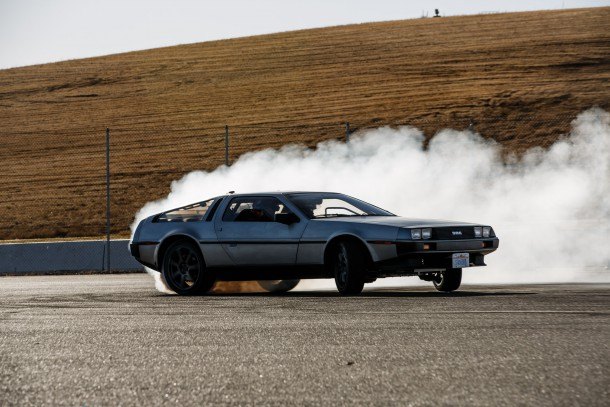Is Stanford's Self-drifting Delorean The Back to the Future of Autonomous Driving? (Video)

I think we can all take a moment to appreciate the fine, fine work that Stanford researchers have put into making a 1981 Delorean do its own donuts in a parking lot on “Back to the Future” day Wednesday. Bravo.
But the car, dubbed MARTY (Multiple Actuator Research Test bed for Yaw control), is more than just epic clickbait for a made-up, 1980s-movie holiday. The car is display for autonomous vehicle control that can go beyond a car’s “safety limits” to exploit physics.
Or, you know, the way you disable stability control to do the same donuts in a nearby parking lot.
Similar to the way rally drivers employ grip and weight control in their cars to safely direct their cars down tree-lined roads at 88 mph, MARTY’s researchers programmed that car to do the same. The point of the exercise is to help autonomous cars use, maximize or even defeat some of its own devices to safely maneuver.
“In our work developing autonomous driving algorithms, we’ve found that sometimes you need to sacrifice stability to turn sharply and avoid accidents,” Chris Gerdes, professor of mechanical engineering at Stanford, said in a statement. “The very best rally car drivers do this all this time, sacrificing stability so they can use all of the car’s capabilities to avoid obstacles and negotiate tight turns at speed. Their confidence in their ability to control the car opens up new possibilities for the car’s motion. Current control systems designed to assist a human driver, however, don’t allow this sort of maneuvering. We think that it is important to open up this design space to develop fully automated cars that are as safe as possible.”
According to the statement, MARTY can really only do donuts right now. Eventually, they’d like the car to navigate a course, sacrificing grip (and tires) for better speed and handling — and probably some safety stuff too.
“The sublime awesomeness of riding in a DeLorean that does perfect, smoke-filled doughnuts by itself is a mind-bending experience that helps you appreciate that we really are living in the future,” Jonathan Goh, a mechanical engineering graduate student in Gerdes’ Dynamic Design Lab said in a statement.
The Delorean is an electric vehicle developed with an automotive, Silicon Valley-based company Renovo Motors.
(H/T to David for the heads up)

More by Aaron Cole
Latest Car Reviews
Read moreLatest Product Reviews
Read moreRecent Comments
- 3SpeedAutomatic At the time, a necessary evil. Development costs were minimal since the FOX body was ready amortized. The green house was the same, just change the front and rear end clips. Biggest news was TBI fuel injection (across the Ford range) and intro of V6 (cylinder head teething issues). Also, allowed Ford to test the waters for an aero look which was handed off to the T-Bird with success. SUVs were just coming on to the scene, so many a LTD wagon was the family hauler and the salesman's means of contacting customers. IIRC, the LTD's model year was purposely extended thru '86 just in case the Tarsus was a flop. Consider the LTD as a sacrifice fly so that the Tarsus could make the home run. 🚗🚗🚗
- Ty I have truly loved each Olds, Buick, and Cadillac I've owned. Well, except for that stupid 1990 STS with a bad brake booster I was too poor to repair. I digress... My love is primarily for the 1895-90 98, Electra/Park, 1986-91 & 92-late 90s 88 (better with the word Delta before it), LeSabre, Bonneville, 1989-93 , 97-99 DeVille. But I have true respect for the Calais/ Skylark (& Somerset)/ Grand Am from that era. They were the work horses. I would buy a brand new Olds if they hadn't executed the brand in 2004.
- MaintenanceCosts What is the actual out-the-door price? Is it lower or higher than that of a G580?
- ToolGuy Supercharger > Turbocharger. (Who said this? Me, because it is the Truth.)I have been thinking of obtaining a newer truck to save on fuel expenses, so this one might be perfect.
- Zerofoo Calling Fisker a "small automaker" is a stretch. Fisker designed the car - Magna actually builds the thing.It would be more accurate to call Fisker a design house.






































Comments
Join the conversation
When on dry pavement, and some wet conditions, you want the ability to lock-up the brakes for the most efficient panic-stop. Friction is your friend here. And there may not be enough distance to stop regardless, so you need to scrub off as much speed as you can, then essentially drift all the way around, say left then right, the car/person/object you're trying to avoid slamming into. Cars tend not to slide to a stop in a straight line anyway, so jerking the wheel left or right as the brakes react, depending on which way you want the car to rotate, is to your advantage, depending on where the exit will be, in case you can't stop within the given distance. So if you can't stop in time, letting off the brakes at the last split second shoots you to the exit you're pointed to, if there is an exit by the time you get there. I've left more than one a bad driver, sitting in a cloud of smoke, wondering what just happened, or didn't happen. Just the screeching tires, can be enough to tell them to stop entering intersection or roadway. Getting on the horn wastes precious time and can be the last thing on your mind.
I'd like to see autonomous car pull off a "Rockford".